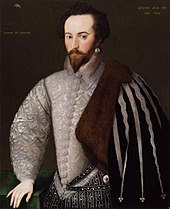Myrtle Grove, Youghal

Myrtle Grove is an Elizabethan gabled house in Youghal, County Cork, Ireland. The house is notable as a rare example in Ireland of a 16th-century unfortified house. It is situated close to the Collegiate Church of St Mary Youghal.[1]
History

It was home for Sir Walter Raleigh from 1588 to 1589. Myrtle Grove's South Gable is where Edmund Spenser is reputed to have written part of his poem The Faerie Queene, although some historians question this story.[2] The house was acquired by Richard Boyle, 1st Earl of Cork in 1602 from Sir Walter Raleigh's Irish estate. Though remodeled twice it remains one of the best-known examples of a Tudor house in Ireland.[3] The house was acquired by Hayman family in the 18th century.[4][5]
In the 20th century, it was the home of Sir Henry Arthur Blake and Lady Blake. At this time, the building housed "the best collection of West Indian paintings and sketches".[6] The Blakes lived here until their deaths. They were buried in the garden.[7]
The house remains in private ownership but is open to the public on certain days of the year.
Legends
The house is reputed to be where potatoes were first planted in Ireland or in Europe.[8] The latter is unlikely however, as potatoes were present only in Spain in 1536. There is a similar legend stating that Myrtle Grove was where tobacco was first smoked by Walter Raleigh.[8] A servant was said to have observed Raleigh from behind and seen smoke rising from him. Thinking that Raleigh was on fire he threw a bucket of water on him to douse the fire. This legend is also however associated with several of Raleigh's other houses.
"Myrtle Grove", a poem written in Spenserian stanzas by James Reiss, and published in Fugue magazine (the University of Idaho) in 2007, develops the legend that Edmund Spenser wrote portions of his great epic, The Faerie Queene, under an aureole window in the South Gable of Raleigh's house.[9]
References
- ^ Lewis, Samuel (1837). A Topographical Dictionary of Ireland. Vol. II. p. 728.
- ^ Michael Twomey (2014). "A good heritage/ tourism story getting in the way of historical facts?". History Ireland. 22 (Issue 1, January/February 2014).
{{cite journal}}:|issue=has extra text (help) - ^ Archiseek (2010). "1550s – Myrtle Grove, Youghal, Co. Cork". Architecture of Cork. Retrieved 3 August 2017.
- ^ Mark Bence-Jones (1988). A Guide to Irish Country Houses. London. ISBN 9780094699908.
{{cite book}}: CS1 maint: location missing publisher (link) - ^ J.B. Burke (1855). A Visitation of the Seats and Arms of the Noblemen and Gentlemen of Great Britain and Ireland. 2nd Series. Vol. II. p. 66.
- ^ William Teignmouth Shore, ed. (1904). "Art Notes". The Academy and literature. 65: 595.
- ^ Patrick Cockburn (27 June 2011). "The girl in the painting". The Independent.
- ^ a b "Myrtle Grove, Church Street, Youghal, County Cork". Buildings of Ireland. National Inventory of Architectural Heritage. Retrieved 3 August 2017.
- ^ "Myrtle Grove". Fugue. Summer/fall 2007: 22–24. 2007.
{{cite journal}}: Italic or bold markup not allowed in:|journal=(help)
